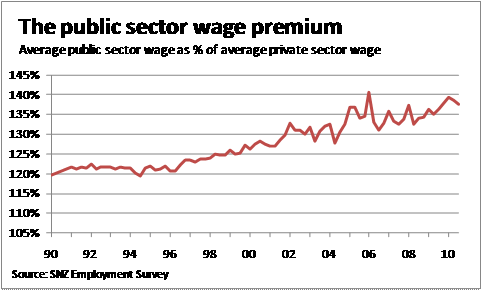Should public sector workers have the right to strike?
In the twelve years from 1998 to 2009 around 250,000 days of work were lost due to industrial action. This is equivalent to over 1,100 effective work years (i.e. after accounting for weekends and holidays). This seems a large number, but when you boil it down it implies that the output of under 100 workers is lost each year due to industrial action. Relative to a workforce that averaged 2.6 million over the period, the direct cost of industrial action represents just $7.5m out of a $190,000m economy.
However, there is a heavy skew in this industrial action. Of the days lost to industrial action, 45% were lost due to work stoppages by public sector workers. Public sector workers make up 11% of the New Zealand workforce, thus public sector workers are four times as likely to be involved in strike action as their private sector counterparts. Put another way, there would be one-third less strike activity in New Zealand if public sector workers had the same propensity for going on strike as the typical private sector worker.
So why is this? A principal reason is that unionisation is primarily a public sector phenomenon in New Zealand. Roughly 60% of union members work in the public sector (defined here as including education and health as well as government administration). This means that roughly 70% of public sector workers are members of a union. In contrast, although 40% of union members work in the private sector, this means that just 6% of private sector workers are union members.
Freedom of association is an important social right, and I do not begrudge public sector workers exercising their preference for collective bargaining and enlisting unions to negotiate employment agreements on their behalf. What is less clear is whether public sector workers should be able to engage in industrial action as part of the bargaining process.
The whole point of industrial action is to use the force of disruption to demonstrate where the balance of power lies between bargaining parties. A difficulty with these demonstrations in the public sector is that a large proportion of the costs of the disruption are born by the public who have no effective voice in the negotiation. Indeed, I would argue that the right to strike results in a balance of power that is disproportionately in favour of public sector unions.
A key reason for this is the lack of external competitive pressures on the negotiating parties. The nature of public sector operations is that there is usually just one, publicly funded, provider of the service. This means that there is usually no obvious alternative supplier of the public service when public servants go on strike. This maximises the disruptive power of strike action. The implication is that public sector workers are naturally in a strong bargaining position, a position that is further strengthened by recourse to industrial action.
In the face of potential strike action, negotiators representing public agencies have to balance the dual goals of minimising the threat of public disruption and that of containing public costs. When push comes to shove, it takes strong political will to face down public disruption in the interest of containing wage costs. As the graph demonstrates, this political will has generally been absent from New Zealand since the mid-1990s. Public-sector wages have typically increased by 1% more than wages in the private sector in each of the last fifteen years. The net impact has been a substantive increase in the cost of the public sector.
Rebalancing bargaining power in the public sector labour market would aid government efforts to improve value for money from the public-sector. One approach would be to remove the right of industrial action by public sector workers. This is already the case for the police, so it is not without precedence. Indeed, the "final offer arbitration" (FOA) negotiation model used by police offers a ready practical alternative.
The emphasis in FOA is on negotiation, but when negotiation fails disputes are resolved with arbitration. The subtle trick to FOA is that the arbitrator must choose between the packages offered by the two sides. Once at arbitration no compromise is allowed. The arbitrator must either choose the union or the employer offer in entirety. The aim of FOA is to encourage a negotiated settlement by introducing uncertainty into the arbitration procedure. Parties who fail to compromise during negotiations risk a total loss on their position. Thus both parties will normally prefer to reach a negotiated settlement. When arbitration is required there will probably be a fundamental difference in view point, which will necessarily be tested by the cogency of the parties' arguments, and not on their ability to be disruptive or to stir up anti-union public sentiment.















